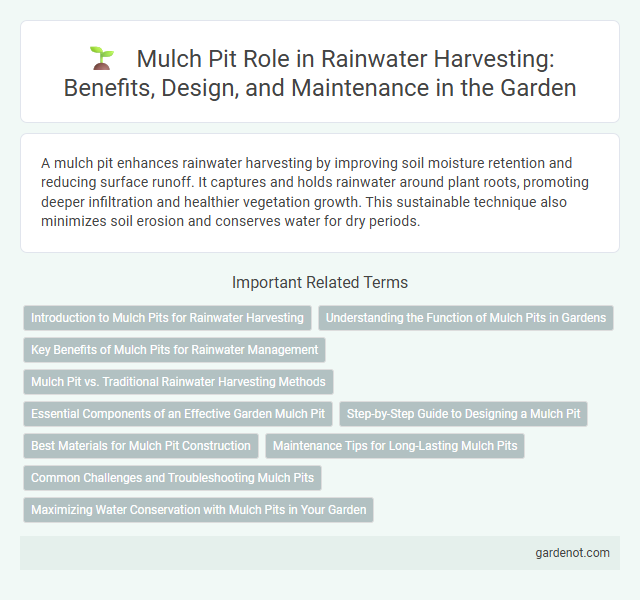A mulch pit enhances rainwater harvesting by improving soil moisture retention and reducing surface runoff. It captures and holds rainwater around plant roots, promoting deeper infiltration and healthier vegetation growth. This sustainable technique also minimizes soil erosion and conserves water for dry periods.
Introduction to Mulch Pits for Rainwater Harvesting
Mulch pits are shallow depressions filled with organic mulch designed to capture and retain rainwater, promoting soil moisture conservation and reducing surface runoff. These pits enhance water infiltration by allowing rainwater to percolate slowly into the ground, benefiting plant roots and improving soil health. Integrating mulch pits in rainwater harvesting systems supports sustainable water management and boosts groundwater recharge.
Understanding the Function of Mulch Pits in Gardens
Mulch pits enhance rainwater harvesting by capturing and retaining moisture around plant roots, reducing evaporation and improving soil hydration. These pits promote deeper water infiltration, preventing runoff and increasing groundwater recharge essential for sustainable garden growth. Properly designed mulch pits also suppress weed growth, maintain soil temperature, and contribute to healthier plant development in garden ecosystems.
Key Benefits of Mulch Pits for Rainwater Management
Mulch pits enhance rainwater management by improving soil moisture retention and reducing surface runoff, which mitigates erosion and groundwater depletion. These pits facilitate the slow infiltration of water into the soil, promoting healthy root development and increasing groundwater recharge rates. Effective mulch pit implementation supports sustainable water usage and boosts plant growth in urban and agricultural landscapes.
Mulch Pit vs. Traditional Rainwater Harvesting Methods
Mulch pits enhance rainwater harvesting by improving soil moisture retention and reducing surface runoff more effectively than traditional methods like ponds or tanks. They use organic mulch to slow water infiltration into the soil, promoting groundwater recharge and minimizing erosion. This technique is cost-effective, environmentally sustainable, and ideal for small-scale water conservation in arid and semi-arid regions.
Essential Components of an Effective Garden Mulch Pit
A garden mulch pit requires a strategically designed basin to capture and retain rainwater efficiently, ensuring deep soil infiltration and reducing surface runoff. Essential components include a well-dug pit with adequate depth and width, layered with organic mulch to minimize evaporation and enhance moisture retention. Incorporating a gravel or sand layer at the base improves drainage, preventing waterlogging and promoting healthy root growth.
Step-by-Step Guide to Designing a Mulch Pit
Start by selecting a suitable site with adequate rainfall runoff and excavate a shallow pit approximately 30-45 cm deep. Line the pit with organic mulch materials like wood chips or straw to improve water retention and soil fertility. Surround the pit with a berm to channel rainwater, ensuring slow infiltration that maximizes groundwater recharge and supports plant growth.
Best Materials for Mulch Pit Construction
Mulch pits are most effective when constructed using organic materials such as wood chips, straw, and shredded leaves that enhance water retention and soil fertility. Incorporating coarse materials like gravel or sand at the base improves drainage and prevents waterlogging, promoting deep infiltration. Selecting locally available, biodegradable mulch materials also supports sustainability and reduces maintenance efforts in rainwater harvesting systems.
Maintenance Tips for Long-Lasting Mulch Pits
Mulch pits require regular inspection to prevent soil erosion and maintain moisture retention for effective rainwater harvesting. Replenish mulch layers periodically with organic materials like wood chips or straw to enhance water absorption and suppress weed growth. Clear debris and monitor drainage channels to ensure proper infiltration and avoid waterlogging in the pit area.
Common Challenges and Troubleshooting Mulch Pits
Mulch pits often face challenges such as poor water infiltration, soil erosion, and mulch decomposition. To troubleshoot, ensure proper pit depth and slope for effective water capture, use high-quality organic mulch to maintain moisture and reduce soil exposure, and regularly inspect for signs of clogging or compaction. Addressing drainage issues with perforated pipes or additional aeration can significantly enhance the pit's efficiency in rainwater harvesting systems.
Maximizing Water Conservation with Mulch Pits in Your Garden
Mulch pits enhance rainwater harvesting by capturing and retaining runoff, allowing water to seep slowly into the soil and reduce evaporation. These pits, filled with organic mulch, improve soil moisture retention and promote healthy plant growth by providing a consistent water supply. Properly designed mulch pits can significantly conserve water in gardens, improving drought resilience and reducing irrigation needs.
Mulch pit Infographic

 gardenot.com
gardenot.com